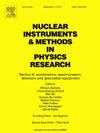Comparison of the simulation of electron beam transport in the double alpha magnet compressor of a 17-MeV electron accelerator using CST PS, TraceWin and RF-Track.✩
IF 1.5
3区 物理与天体物理
Q3 INSTRUMENTS & INSTRUMENTATION
Nuclear Instruments & Methods in Physics Research Section A-accelerators Spectrometers Detectors and Associated Equipment
Pub Date : 2025-04-15
DOI:10.1016/j.nima.2025.170541
引用次数: 0
Abstract
The ELSA facility is a 30 MeV electron accelerator with a double alpha magnet compressor positioned between two acceleration stages. Optimizing beam transport and determining the emittance limits of this device are key to the future development of the inverse Compton X-ray source developed on ELSA, making accurate simulations —along with a thorough understanding of their assumptions and limitations— essential. Three different codes, namely CST PS, TraceWin and RF-Track, each based on different principles, have been compared in the specific case of relativistic electron bunches with short curvature radii trajectories in the alpha magnet compressor. Since CST PS and RF-Track make calculations in the laboratory frame while TraceWin works in the bunch reference frame, a direct comparison could not be achieved directly. It was enabled through the development of a robust numerical method that derives phase space and emittance in the bunch frame from the positions and momenta of the particles in the laboratory frame (as exported from CST PS and RF-Track). This method is fully described in this paper.
使用CST PS、TraceWin和RF-Track模拟17-MeV电子加速器双α磁体压缩机中电子束输运的比较
ELSA设备是一个30 MeV的电子加速器,在两个加速级之间有一个双α磁铁压缩机。优化光束传输和确定该设备的发射度限制是在ELSA上开发的逆康普顿x射线源的未来发展的关键,进行准确的模拟-以及对其假设和限制的透彻理解-至关重要。以α磁体压缩机中具有短曲率半径轨迹的相对论性电子束为例,比较了基于不同原理的CST PS、TraceWin和RF-Track三种编码。由于CST PS和RF-Track是在实验室框架下进行计算,而TraceWin是在束参考框架下进行计算,因此无法直接进行比较。它是通过开发一种强大的数值方法实现的,该方法从实验室框架中粒子的位置和动量中导出束框架中的相空间和发射度(从CST PS和RF-Track导出)。本文对该方法进行了详细的描述。
本文章由计算机程序翻译,如有差异,请以英文原文为准。
求助全文
约1分钟内获得全文
求助全文
来源期刊
CiteScore
3.20
自引率
21.40%
发文量
787
审稿时长
1 months
期刊介绍:
Section A of Nuclear Instruments and Methods in Physics Research publishes papers on design, manufacturing and performance of scientific instruments with an emphasis on large scale facilities. This includes the development of particle accelerators, ion sources, beam transport systems and target arrangements as well as the use of secondary phenomena such as synchrotron radiation and free electron lasers. It also includes all types of instrumentation for the detection and spectrometry of radiations from high energy processes and nuclear decays, as well as instrumentation for experiments at nuclear reactors. Specialized electronics for nuclear and other types of spectrometry as well as computerization of measurements and control systems in this area also find their place in the A section.
Theoretical as well as experimental papers are accepted.

 求助内容:
求助内容: 应助结果提醒方式:
应助结果提醒方式:


